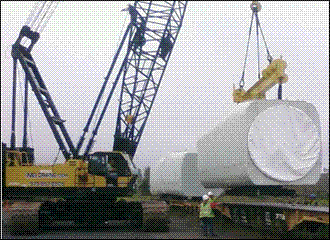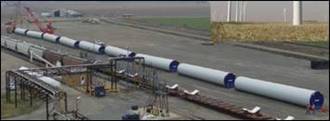BNSF Logistics Taps its Multimodal Expertise for Strategic Growth
Springdale, Arkansas USA Site Visit
July 10, 2012
By
Evan Armstrong
Key Personnel:
Ray Greer – President
Eric Wolfe – Chief Operating Officer
Dan Curtis – Chief Financial Officer
Jim Craig – Chief Marketing Officer
Mike Lancaster – Vice President & General Manager, BNSF Logistics International
Andy Cordischi – Vice President, Solutions
Lorne Campbell – Vice President, Technology
Robert Sutton – Vice President, Specialty Services
Yancey Bowen – Vice President, Domestic OTR
BNSF Logistics Overview & Strategic Vision
Founded in 2002, BNSF Logistics (BNSFL) has grown rapidly. In 2011, its freight under management topped $400 million generating gross revenue of $350 million and $51 million in net revenue. BNSFL provides both non-asset based domestic and international transportation management services and has taken significant steps to reposition itself in the third-party logistics market from a solely domestic over-the-road transportation manager to a multimodal domestic transportation manager with integrated international transportation management capabilities. From 2004 to 2011, BNSFL’s Rail Logistics revenues have grown at a compound annual growth rate of 37.3%. As a sister company to the BNSF Railway and a Berkshire Hathaway Company, BNSF Logistics has significant resources for a company of its size in the 3PL space.
BNSFL has 380 employees stationed in over 50 operating locations. It adds scale to its corporate owned domestic transportation management operations with 21 exclusive agents and has built a network of global agents to support its international transportation management offering. BNSFL’s key accounts include: Walmart, LG, Kohl’s, Rio Tinto, Gamesa, and Ryerson. Its overall domestic operating segments, revenues, and margins are detailed in the figure below.
BNSFL Key Domestic Results Detail its Strategic Gains in Multimodal Logistics Management

In 2010, BNSF made a key management shift bringing on Ray Greer to head up BNSF Logistics. Ray’s career includes previous positions as chief executive officer of Greatwide Logistics and president of Ryder Integrated Logistics. According to Ray, “2011 was a level setting year.” BNSF Logistics realigned its internal organization and operations, made back office operational improvements, and finalized its IT strategy. Ray iterated, “We have aligned our operations to provide customers with a legitimate global 3PL alternative. We truly excel if customers need a multimodal transportation solution with a rail component.”
BNSFL is targeting to grow revenue to $1.5 billion by 2016. It plans on deriving incremental revenues from further acquisitions ($600 million to $1.2 billion), $300 million in domestic transportation management sales from organic domestic direct sales and company store sales efforts, $100 million from new products and services, $100 million from new agent operations, and $40 million from increased international transportation management sales. As initial steps to reach these goals, BNSFL is expanding its outside sales force from 10 to 30 and added four company domestic/international offices in 2011 in major coastal/hub markets. These new offices are located in Seattle, Long Beach, Miami, and Newark. BNSFL is on track to add four additional offices in 2012. It is also proactively adding agents in more rural “fly over” states/locations.
Expanding Oil & Natural Gas Logistics Support Business in the Bakken Formation
A rapidly growing business for BNSFL has been coordinating oil drilling rig moves and supporting natural gas “fracking” operations in the Bakken Formation, which runs from Canada south into Montana and North Dakota. According to the latest 2008 United States Geological Survey, the Bakken Formation of the Williston Basin Province in Montana and North Dakota has estimated average undiscovered volumes of 3.65 billion barrels of technically recoverable oil, 1.85 trillion cubic feet of associated/dissolved natural gas, and 148 million barrels of natural gas liquids. (Technically, recoverable oil resources are those producible using currently available technology and industry practices.) Furthermore, according to OilShaleGas.com, there are now over 6,000 active oil wells in the Bakken Formation with most activity in Montana and North Dakota.
Bakken Formation, a Significant New Domestic Source of Oil and Natural Gas

In support of the Bakken oil drilling operations, BNSFL is managing as many as 10 to 15 oil rig moves per month for multiple oil & gas exploration companies including Continental Resources and Brigham Oil. Each move requires approximately 30 days to relocate a rig from one location to another and is logistically challenging. To assemble a rig, 20 to 30 truckloads of materials and components are needed. In addition, overhead cranes are required to unload many of the larger rig components. To locally coordinate the oil rig moves, BNSFL opened an office in Williston, North Dakota last year.
Natural gas hydraulic fracturing or “fracking” is a way to extract natural gas in deep well drilling. Once a natural gas well is drilled, millions of gallons of water, “frac” sand, and a small amount of proprietary chemicals are injected under high pressure into a well. The high pressure fractures the shale and opens fissures enabling the natural gas to be pumped out of the well.
To support the expanding Bakken fracking operations, BNSFL manages inbound transportation for multiple exploration/drilling companies to the drilling sites. Inbound materials include drilling pipe, pumping units, frac sand, and fracking chemicals. The frac sand is sourced domestically from mines in Illinois and Wisconsin and a small amount of “ceramic” sand is imported via ocean containers from China and Brazil. BNSFL supports frac sand moves with door-to-door ocean import services, rail to truck transload services and intermodal rail-truck deliveries. In 2011, BNSFL transloaded sand from 528 rail hopper cars to trucks for final delivery to drilling sites. To further emphasize the scale of the Bakken Formation natural gas exploration/drilling operations, BNSFL’s parent BNSF Railway delivered over 25,000 railcars of frac sand into the Bakken last year.
Rail Transload Services Add to BNSFL’s Growth
Specialized domestic transportation management services now comprise 30% of BNSFL’s overall revenue and 25% of its gross margin. Rail transloading is a significant portion of the specialized services business and is driving over half of its growth. It combines the use of railroad and over-the-road transportation management services to deliver goods. A good example of BNSFL’s rail transloading capabilities involves its wind energy operations.
Since 2009, when it began working with wind turbine power generator manufacturer Gamesa Wind USA, BNSFL has been supporting the creation of domestic wind energy farms. In 2010, BNSFL was also tapped by wind energy manufacturer Vestas to support its logistics needs.
Each wind turbine power generator has four primary components:
- The turbine tower is assembled using 3-4 sections each weighing from 70-95,000 pounds.
- Nacelles are the top part of the wind turbine that generates electricity. Each weighs 150-200,000 pounds and has an approximate value of $1.4 million.
- Hubs are the front part of the wind turbine which the blades are attached to and are in-turn attached to the nacelle.
- Blades are fastened to the hub for power generation. Each blade weighs 5-6,000 pounds and has a value of $150-200,000.

 To support the building of wind farms in the U.S., BNSFL managed the rail and over-the-road transportation of components from ocean ports and manufacturers to transload sites and final delivery. It works with the railroads to develop load plans, uses CAD (computer animated design) applications to engineer component “tie down” specifications, and develops optimal rail routings which take required dimensional clearances into account. At each transload site managed by BNSFL, it hires cranes and riggers as needed to transload components off of railcars onto specialized over-the-road transportation providers for final delivery. In addition to managing the transload site, in some cases BNSFL has also designed the transload site and leased the location for its operations.
To support the building of wind farms in the U.S., BNSFL managed the rail and over-the-road transportation of components from ocean ports and manufacturers to transload sites and final delivery. It works with the railroads to develop load plans, uses CAD (computer animated design) applications to engineer component “tie down” specifications, and develops optimal rail routings which take required dimensional clearances into account. At each transload site managed by BNSFL, it hires cranes and riggers as needed to transload components off of railcars onto specialized over-the-road transportation providers for final delivery. In addition to managing the transload site, in some cases BNSFL has also designed the transload site and leased the location for its operations.
Each wind farm project runs from six to nine months. In 2011, BNSFL managed the delivery of 1,775 wind generator components including: 1,087 tower sections, 310 nacelles, 87 hubs, and 291 blades.
BNSF Logistics International Gains Traction
While BNSFL’s international division only represents 12% of total revenues, it has been growing rapidly since 2009 and is a key area targeted for future growth. As part of its growth objectives, BNSFL International has added offices in Minot, ND; Seattle, WA and Newark, NJ. It is also planning on opening offices in Minneapolis, Chicago, Long Beach, and Atlanta in the next two years. According to BNSFL International, it is also currently reviewing expansion opportunities in Brazil and India.
BNSFL International’s core service offerings include:
► Global ocean transportation (NVOCC, Ocean Freight Forwarder)
• Door to door, port to door and port to port
• Project freight
• Ro/Ro (roll-on/roll-off)
• FCL (full container load) and LCL (less than container load)
► Global air transportation (International Airfreight Forwarder)
• Expedited, charter, door to door, airport to door and airport to airport
► Customs brokerage
• Customs clearance, reconciliation, duty drawback, temporary import bonds and customs
compliance
► Value-added services
• Insurance, AES (automated export system) filings, letters of credit and purchase order
management
BNSFL International has seen significant growth in all of its service segments. Its ocean business has grown 967% from managing 10,480 TEUs (trailer equivalent units) in 2009 to 20,612 TEUs in 2011. For 2012, BNSFL International is currently managing 145% more TEUs than it did in 2011.
While international airfreight forwarding has been a sore spot for most freight forwarders over the last year and a half, BNSFL International has grown its volumes 361% from 1.69 million kilos in 2009 to 2.30 million kilos in 2011. It is realizing 80% year-over-year growth in airfreight volumes for 2012 compared to 2011.
In addition, BNSFL International’s customs brokerage entries are up 57% from 2009 to 2011 and it is seeing 108% year-over-year growth from 2011 to 2012.
To support operations, BNSFL International deployed the CargoWise international transportation management system in 2011 for operations and end-to-end shipment visibility.
BNSF Logistics Summary
BNSF Logistics has been expanding its multimodal and international operations. Oil & Gas, Energy, and other customers are deriving significant benefits from BNSFL’s combined rail and over-the-road transportation management capabilities. In-turn, customers are leveraging its expanding integrated international transportation management capabilities. BNSFL’s diverse business model is allowing it to grow revenues and deliver solid margins.
Sources: A&A Primary Research, http://www.bnsflogistics.com/


